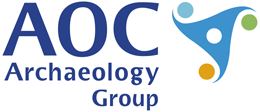Mayflower Plaza, Commercial Road, Southampton (aocarcha1-138220 and aocarcha1-122004)
AOC Archaeology Group, 2013. https://doi.org/10.5284/1022577. How to cite using this DOI
Data copyright © AOC Archaeology Group unless otherwise stated
This work is licensed under the ADS Terms of Use and Access.
Primary contact
AOC Archaeology Group
Unit 7
St Margaret's Business Centre
Twickenham
TW1 1JS
UK
Resource identifiers
- ADS Collection: 1269
- DOI:https://doi.org/10.5284/1022577
- How to cite using this DOI
Introduction
![Mayflower Plaza, Commercial Road, Southampton. Soakaway [311] N.](images/sou_1587_2.png)
A programme of archaeological evaluation was undertaken on a site formerly occupied by domestic and commercial properties along Commercial Road and West Park Road, in Southampton. The buildings that once occupied the site were demolished following bomb damage during the Second World War, and by general site clearance in the 1980s and 1990s.
Much of the potential archaeological horizons of the site had been reworked through agriculture, horticulture, and the establishment of the properties on the site during the late 19th century, which comprised basements and significant concrete footings.
Three archaeological features were recognised during the archaeological evaluation. One of these was a shallow gully running northwest-southeast, roughly oriented to the historic Conduit House. This was potentially the location for a medieval conduit that ran from springs on Hill Lane to the city. However, no conduit was present. In both locations seen, there was a 19th century intrusion, so if the conduit had been present, it may have been physically removed in the past. The second feature was an infilled ditch running roughly north-south, which may have been filled around 1600AD. This represents a field or property boundary. The third feature was a small curving trench that revealed medieval pottery, and is the scant remnant of a feature of medieval date, of uncertain function.
Much of the 19th century activity on site was related to households and their associated drainage. Of note was one concrete-bound ceramic pipe, running downhill roughly southwards into a soakaway. This may be a storm drain from Commercial Road, or it may mark the location of the water supply from Conduit House, being simply diverted.
The evaluation has revealed that the conduit, if originally present, has been removed, and the only other feature surviving to significant depth is the field boundary. However, the foundation design is likely to require terracing of the site to enable piling to be conducted from a series of level platforms. The already truncated medieval feature and part of the medieval boundary ditch will be impacted by these works. Therefore it is recommended that any further archaeological work in relation to the development should be limited to a low level watching brief.
The physical archive has been deposited at Southampton City Museum with the accession/site code SOU1587.






